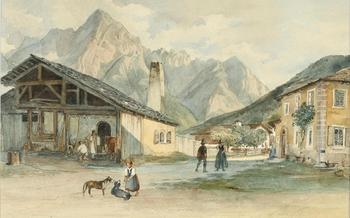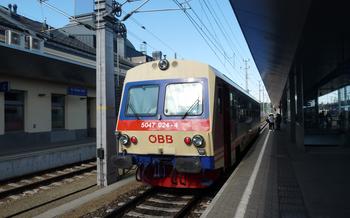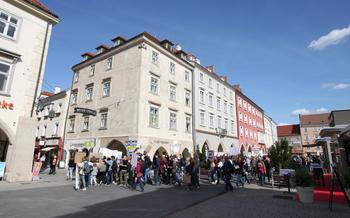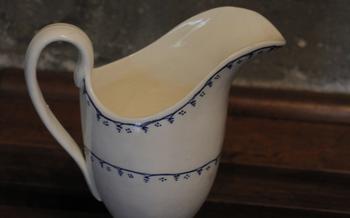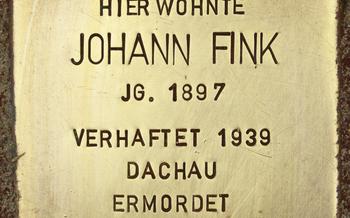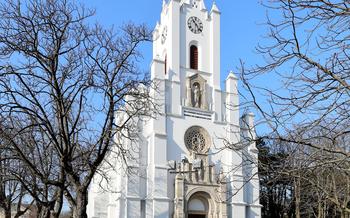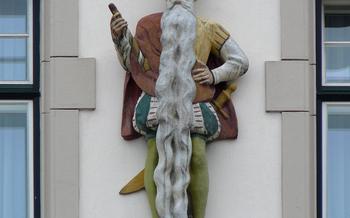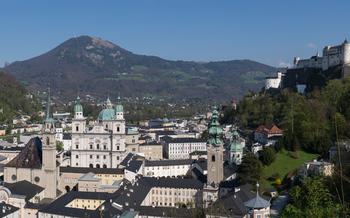
St. Peter an der Sperr
- St. Peter an der Sperr: A Historic Gem in Wiener Neustadt
- Exploring the Exterior: A Symphony of Gothic and Romanesque
- Stepping Inside: A Journey Through Time
- The High Altar: A Masterpiece of Craftsmanship
- The Side Altars: Hidden Treasures of Devotion
- The Pulpit: A Platform for Divine Words
- The Organ: A Symphony of Sacred Sounds
- The Tombs and Epitaphs: Whispers of the Past
- The Crypts: A Journey into the Depths
- St. Peter an der Sperr Museum: Unveiling the Church's Treasures
- Pilgrimage and Religious Significance
- Music and Cultural Events: A Stage for Sacred Sounds
- Guided Tours: Unveiling Secrets and Legends
- Accessibility and Practical Information
- Insider Tip: Hidden Corners and Photographic Opportunities
St. Peter an der Sperr: A Historic Gem in Wiener Neustadt
In the heart of Wiener Neustadt, Austria, stands a magnificent architectural treasure – the St. Peter an der Sperr church. This historic gem, dating back to the 12th century, holds a prominent place in the city's religious and cultural landscape. As one of the oldest and most significant churches in the region, St. Peter an der Sperr invites visitors to embark on a journey through time, unveiling its rich history, architectural wonders, and spiritual significance.
Originally constructed as a Romanesque basilica, the church underwent significant renovations and expansions over the centuries. It proudly displays a harmonious blend of Romanesque and Gothic architectural elements, showcasing the evolving styles and artistry of different eras. Step inside and prepare to be captivated by the stunning stained glass windows, intricate carvings, and awe-inspiring frescoes that adorn the interior.
St. Peter an der Sperr is not merely a testament to architectural prowess; it also holds deep religious significance for the people of Wiener Neustadt. Dedicated to Saint Peter, the patron saint of fishermen and gatekeepers, this church has served as a spiritual haven for centuries, attracting pilgrims and worshippers from near and far. Its enduring legacy as a place of prayer, reflection, and community gatherings makes it a beloved landmark in the city.
Exploring the Exterior: A Symphony of Gothic and Romanesque
St. Peter an der Sperr's exterior is a captivating blend of Gothic and Romanesque architectural styles. Constructed in the 13th century, the church showcases various Gothic elements, including pointed arches, ribbed vaults, and flying buttresses. These features lend the building a sense of height and lightness, typical of Gothic architecture.
In contrast to the Gothic elements, the church also exhibits several Romanesque influences. The semi-circular arches over the windows and the robust, rounded pillars in the nave are examples of Romanesque style. The combination of these two architectural styles creates a harmonious and visually appealing exterior.
Intricate carvings and sculptures adorn the church's facade, adding to its visual richness. These intricate details depict biblical scenes, saints, and mythical creatures, offering a glimpse into the artistic and religious sensibilities of the medieval period. The exterior of St. Peter an der Sperr is a testament to the craftsmanship and creativity of the builders who erected this architectural masterpiece.
Stepping Inside: A Journey Through Time
As you cross the threshold of St. Peter an der Sperr, you are transported back in time, surrounded by an aura of history and devotion. The interior of the church is a testament to the artistic and spiritual heritage of Wiener Neustadt.
The first thing that catches your eye is the breathtaking array of stained glass windows, casting a kaleidoscope of colors onto the stone walls. These windows, meticulously crafted by master artisans, depict scenes from the Bible and the lives of saints, narrating stories of faith, hope, and redemption.
As you gaze upwards, the ornate frescoes and paintings adorning the walls and ceiling draw your attention. These vibrant masterpieces, executed with exquisite detail, depict religious figures, angels, and heavenly scenes. The vivid colors and skillful brushstrokes bring the stories to life, creating an immersive experience for the viewer.
The grandeur of the nave, with its soaring columns and intricate vaulting, is simply awe-inspiring. The sheer scale and architectural harmony of the space create a sense of reverence and tranquility. The play of light and shadow, filtering through the stained glass windows, adds a touch of ethereal beauty to the atmosphere.
The High Altar: A Masterpiece of Craftsmanship
The high altar of St. Peter an der Sperr is an awe-inspiring masterpiece of intricate carvings, elaborate gilding, and profound symbolism. This magnificent centerpiece commands attention at the heart of the church, transporting visitors to a realm of sacred artistry.
Crafted by skilled artisans in the 15th century, the altar boasts a breathtaking triptych depicting scenes from the life of Christ. The central panel showcases the crucifixion, with Jesus Christ rendered in exquisite detail amidst a flurry of angels and mourners. Flanking this centerpiece, the left and right panels depict the Annunciation and the Resurrection, respectively.
Every inch of the altar is adorned with intricate carvings that tell their own unique stories. From the delicate tracery of the pinnacles to the lifelike depictions of saints and biblical figures, the altar reflects the deep reverence and artistic prowess of its creators.
The high altar serves as a focal point for the congregation during religious ceremonies, inviting them to contemplate the mysteries of faith and the sacrificial love of Jesus Christ. Its grandeur and symbolism make it a true treasure of St. Peter an der Sperr, leaving an indelible mark on the hearts and minds of all who behold it.
The Side Altars: Hidden Treasures of Devotion
The side altars of St. Peter an der Sperr are a testament to the diverse artistic styles and devotional traditions that have shaped the church's interior. Dedicated to various saints, these altars showcase exquisite craftsmanship and intricate details, each with its unique story to tell.
The altar of St. Catherine, located in the southern aisle, stands out with its delicate Gothic tracery and vibrant colors. Dedicated to the patron saint of philosophers and scholars, the altar features a beautiful statue of St. Catherine, surrounded by intricate carvings depicting scenes from her life.
In contrast, the altar of St. Sebastian, located in the northern aisle, exudes a more somber and dramatic atmosphere. Dedicated to the patron saint of plague victims, the altar features a poignant depiction of St. Sebastian pierced by arrows, surrounded by scenes of suffering and martyrdom.
The variety of styles and designs on these side altars reflects the diverse influences that have shaped St. Peter an der Sperr over the centuries. From the delicate Gothic tracery of the St. Catherine altar to the somber realism of the St. Sebastian altar, these hidden treasures offer a glimpse into the rich tapestry of the church's history and devotion.
The Pulpit: A Platform for Divine Words
The pulpit of St. Peter an der Sperr, situated majestically within the nave, serves as a powerful symbol of divine communication. Its intricate carvings and sculptures, a testament to the artistry and craftsmanship of the era, depict the four evangelists: Matthew, Mark, Luke, and John. Each evangelist is depicted with their traditional symbol, creating a profound visual representation of their roles in spreading the Christian message.
The pulpit's central position within the church reflects its importance as a platform for delivering the word of God. It is here that the priest or preacher stands, connecting with the congregation and sharing messages of faith, hope, and redemption. The ornate carvings and the symbolism of the four evangelists add a layer of solemnity and grandeur to the pulpit, emphasizing its role as a sacred space.
Over the centuries, the pulpit has witnessed countless sermons, prayers, and proclamations. The echoes of divine words have resonated within its walls, leaving an imprint of spiritual legacy and devotion. It has served as a platform for sharing stories, parables, and teachings that have shaped the hearts and minds of generations of worshippers.
The pulpit at St. Peter an der Sperr is more than just a decorative element; it is a symbol of religious authority and a reminder of the power of the spoken word. It stands as a testament to the enduring significance of faith and the ways in which the church has communicated its messages throughout history.
The Organ: A Symphony of Sacred Sounds
The majestic organ of St. Peter an der Sperr, with its impressive pipes and intricate carvings, stands as a testament to the church's rich musical tradition. Built in the 18th century, the organ has undergone several renovations and expansions, resulting in its current grandeur.
The organ's rich history is closely intertwined with the cultural heritage of Wiener Neustadt. It has been played by renowned organists throughout the centuries, and its music has filled the church with sacred sounds during countless religious services, concerts, and special events.
To this day, the organ continues to play a vital role in the liturgical life of St. Peter an der Sperr, accompanying the singing of the congregation and enhancing the atmosphere of worship. Regular concerts and performances by talented organists showcase the instrument's versatility and the diverse range of music it can produce.
The organ's majestic presence and captivating sounds create a truly awe-inspiring experience for visitors. Whether you are a music enthusiast, a history buff, or simply someone who appreciates the beauty of sacred art, the organ of St. Peter an der Sperr is a must-see attraction.
The Tombs and Epitaphs: Whispers of the Past
The tombs and epitaphs within St. Peter an der Sperr serve as poignant reminders of the lives that have intersected with this sacred space. Intricate carvings and inscriptions adorn these final resting places, paying tribute to influential figures from Wiener Neustadt's rich history.
As you wander among the tombs, you'll encounter elaborate carvings that depict scenes from the lives of the deceased, capturing their essence in stone. Epitaphs, with their carefully chosen words, offer glimpses into the personalities and accomplishments of those laid to rest here.
Among the notable tombs is that of Hans von Puchheim, a 16th-century knight and military commander whose life was marked by bravery and honor. His tomb, adorned with intricate carvings and a life-size effigy, stands as a testament to his legacy.
Another notable tomb belongs to Maria Magdalena von Lamberg, a devout Catholic who dedicated her life to charitable works. Her epitaph, written in Latin, extols her virtues and the impact she had on the community.
These tombs and epitaphs not only provide a glimpse into the lives of the departed but also offer a deeper understanding of the cultural and historical significance of St. Peter an der Sperr. They serve as a reminder that within these walls lies a tapestry of stories, each one contributing to the rich heritage of this sacred space.
The Crypts: A Journey into the Depths
Beneath the grandeur of St. Peter an der Sperr lies a hidden world of history and mystery—the crypts. These ancient burial chambers, built in the 13th century, offer a glimpse into the past and the lives of those who have been laid to rest within their walls.
Descend the narrow stone steps into the dimly lit crypts, and you'll be greeted by an eerie silence. The air is cool and damp, and the walls are lined with rows of stone coffins, each bearing intricate carvings and inscriptions. These tombs tell the stories of the departed, from noble families to ordinary citizens, who once walked the streets of Wiener Neustadt.
Among the most notable individuals buried in the crypts is Bishop Heinrich von Traun, who died in 128His tomb, adorned with a life-size effigy, is a testament to his importance and influence. Other notable figures include members of the Habsburg dynasty, who ruled over Austria for centuries.
The crypts offer a unique perspective on the history and culture of Wiener Neustadt. They provide a glimpse into the lives of the city's former residents, their beliefs and their social structures. Whether you're a history buff, an architecture enthusiast, or simply curious about the past, the crypts of St. Peter an der Sperr are a must-visit destination.
St. Peter an der Sperr Museum: Unveiling the Church's Treasures
Delve into the rich history and significance of St. Peter an der Sperr through its dedicated museum. Located within the church premises, the museum houses a captivating collection of artifacts, religious objects, and documents that shed light on the church's past. From ancient manuscripts and vestments to intricate sculptures and paintings, the museum offers a glimpse into the spiritual and artistic heritage of this sacred site. Guided tours and educational programs provide visitors with in-depth insights into the museum's treasures, as well as the broader history and cultural significance of St. Peter an der Sperr. Whether you're a history buff, an art enthusiast, or simply seeking a deeper understanding of this remarkable church, the St. Peter an der Sperr Museum is a must-visit.
Pilgrimage and Religious Significance
Throughout its history, St. Peter an der Sperr has been a significant pilgrimage site, attracting devout believers from near and far. The church is dedicated to St. Peter, one of the most revered saints in Christianity, and is believed to possess a relic of the saint, further enhancing its spiritual allure. Pilgrims have flocked to St. Peter an der Sperr for centuries, seeking solace, guidance, and spiritual renewal.
The veneration of St. Peter is deeply ingrained in the church's identity and history. St. Peter, known as the "rock" upon which Jesus built his church, holds a special place in the hearts of many Christians. Pilgrims come to St. Peter an der Sperr to pay homage to the saint, to seek his intercession, and to experience the profound sense of spirituality that permeates the church.
Beyond its role as a pilgrimage site, St. Peter an der Sperr continues to be an active center of religious devotion. Regular masses, prayer services, and other religious events are held within its hallowed walls, fostering a vibrant community of believers. The church's ongoing spiritual significance is a testament to its enduring power as a place of worship, contemplation, and connection with the divine.
Music and Cultural Events: A Stage for Sacred Sounds
St. Peter an der Sperr is not only a place of worship but also a vibrant cultural hub. The church regularly hosts concerts and performances, showcasing a diverse range of musical genres from classical to contemporary. These events not only enhance the spiritual experience but also contribute to the cultural vibrancy of Wiener Neustadt.
Music has always played an integral role in the church's history. In the past, the church choir and organists filled the sacred space with their melodious renditions of hymns and sacred music. Today, the tradition continues with regular performances by renowned musicians and ensembles.
The acoustics of the church, with its high vaulted ceilings and spacious nave, create an immersive soundscape that enhances the musical experience. Whether it's the soaring melodies of a classical symphony or the soulful notes of a contemporary composition, the music resonates through the church, touching the hearts and minds of all who listen.
These concerts and performances are not just limited to religious music. The church also hosts cultural events such as art exhibitions, lectures, and film screenings, creating a platform for dialogue and exploration. By embracing a variety of artistic expressions, St. Peter an der Sperr fosters a sense of community and cultural exchange.
Attending a concert or event at St. Peter an der Sperr is a unique and enriching experience. It offers visitors the opportunity to immerse themselves in the beauty of the church's architecture, appreciate the talents of gifted musicians, and engage with the vibrant cultural scene of Wiener Neustadt.
Guided Tours: Unveiling Secrets and Legends
To truly delve into the depths of St. Peter an der Sperr's history and significance, embarking on a guided tour is an enriching experience. Knowledgeable guides, passionate about the church's heritage, lead visitors on an immersive journey through its sacred spaces. Their insightful commentary sheds light on the intricate details, hidden meanings, and captivating stories that lie within the church's walls.
With a guided tour, visitors discover the symbolism embedded in the church's architecture, the stories behind the stunning stained glass windows, and the significance of the various altars and sculptures. They gain a deeper understanding of the church's role in the religious and cultural history of Wiener Neustadt and the surrounding region.
Guided tours offer a unique opportunity to ask questions, delve into specific aspects of the church's history or art, and gain a personalized experience tailored to individual interests. Whether visitors are history buffs, art enthusiasts, or simply curious about the spiritual significance of St. Peter an der Sperr, a guided tour promises to unveil the secrets and legends that make this church a captivating destination.
Accessibility and Practical Information
St. Peter an der Sperr is open to the public during specific hours and offers guided tours for a deeper understanding of its history and significance. Admission fees are nominal, ensuring accessibility for all visitors. The church is wheelchair accessible, allowing individuals with disabilities to fully experience its beauty and grandeur. To enhance your visit, consider planning ahead by checking the official website for the church's updated schedule and any special events or closures.
Practical Tips:
- Opening Hours:
- Tuesday to Saturday: 10:00 AM - 5:00 PM
-
Sunday: 12:00 PM - 5:00 PM
-
Admission Fees:
- Adults: €5
- Children (6-14 years): €2
-
Family Ticket (2 adults and 2 children): €12
-
Guided Tours:
- Available upon request
- Pre-booking recommended for groups
- Duration: Approximately 60 minutes
-
Fees may apply
-
Accessibility:
- Wheelchair accessible
- Designated parking spaces for individuals with disabilities
-
Assistance available upon request
-
Planning Your Visit:
- Check the official website for the latest information on opening hours and special events.
- Consider visiting during off-peak hours to avoid crowds and enjoy a more intimate experience.
- Allow sufficient time to explore the church's interior and exterior, as well as the surrounding area.
Insider Tip: Hidden Corners and Photographic Opportunities
As you explore St. Peter an der Sperr, keep an eye out for hidden corners and photographic opportunities that will capture the essence of this historic gem. For a unique perspective, head to the bell tower and climb the spiral staircase to the top. From here, you'll be rewarded with breathtaking panoramic views of Wiener Neustadt and the surrounding countryside.
Don't miss the opportunity to capture the intricate details of the church's exterior. The Gothic pinnacles and flying buttresses, as well as the Romanesque portal, provide ample subjects for stunning photographs. Step inside and look for the hidden carvings and sculptures that adorn the walls and columns. These often-overlooked details offer a glimpse into the rich history and craftsmanship that went into building this masterpiece.
The surrounding area of St. Peter an der Sperr is also worth exploring. Take a stroll through the charming streets of Wiener Neustadt and discover hidden courtyards, picturesque alleys, and historic buildings. Capture the essence of this vibrant city and its rich cultural heritage through your lens.
Remember to be respectful of the church's sacred nature and avoid disturbing ongoing services or ceremonies. With a keen eye and a little patience, you'll uncover the hidden treasures of St. Peter an der Sperr and create lasting memories of your visit.

